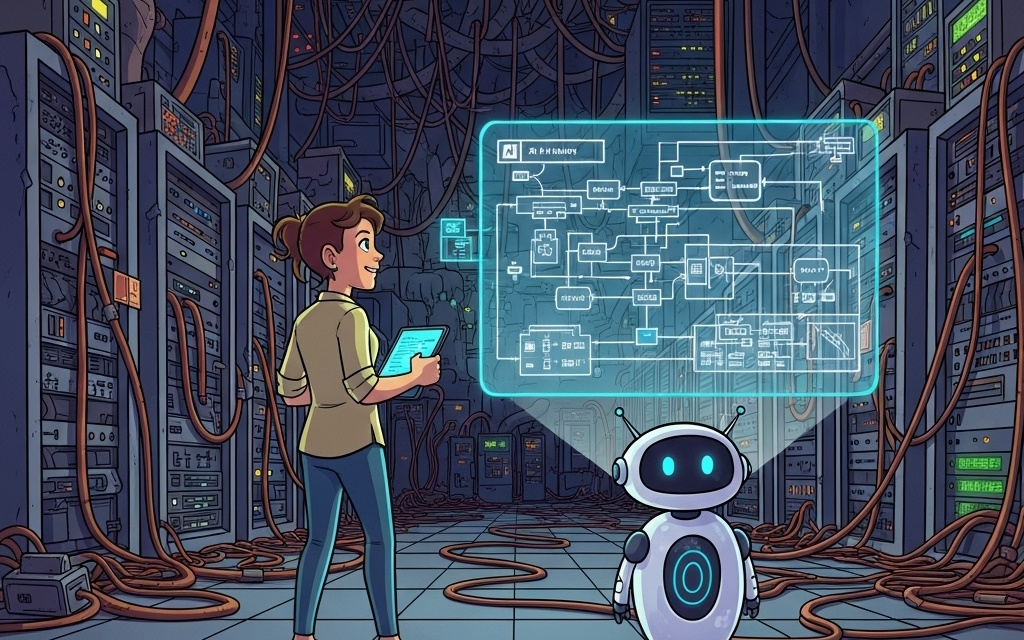Have you ever been in this scenario? You’re cruising along, confident in your domain, when suddenly a curveball comes your way. A colleague leaves, and their entire project lands on your plate. Or perhaps you’re a new hire, and the sheer scale of the company’s existing systems feels like trying to find your way out of a sprawling, unfamiliar labyrinth of files and directories that offers little in the way of immediate understanding.
A map of the land would be invaluable. In software, this often means some sort of diagram. But even if you were lucky enough to find a diagram, is it even up to date? Traditionally, this scenario meant days, even weeks, of painstaking detective work—staring at cryptic code to map out the functionality and relationships of each component. It’s a truly painstaking process.
But what if you could leverage AI to help you?
The AI-Generated Diagrams: Your Architectural Compass
We can think of a Large Language Model (LLM) as a fast, highly trained wordsmith. But can it analyze code and convert it into a graphical diagram? While an LLM won’t replace your deep analytical skills, it can certainly handle the initial heavy lifting, allowing you to focus on the nuanced problems. Here’s a practical workflow to leverage AI for rapid diagram generation:
1. Feeding the Code (Safely)
The first step is getting your code into the LLM. This sounds simple, but it comes with a crucial caveat: data privacy and trust. This is paramount, especially when dealing with proprietary or sensitive code.
- Cloud-based LLMs (e.g., Google Gemini, ChatGPT): These are powerful and easy to access. However, you must carefully consider the LLM provider’s data handling policies. Do they use your uploaded code for training their models? How long is it retained? For highly sensitive internal code, simply copy-pasting or providing URLs to private repositories might not be an option due to security concerns. Always check your company’s policies before using external services with proprietary data.
- On-premise or Self-hosted LLMs: For maximum privacy and control, especially with extremely sensitive code, exploring open-source LLMs that can be run on your own infrastructure (like certain versions of Llama or Code Llama) is an option. This requires more technical setup and computational resources, but it ensures your code never leaves your controlled environment.
Once you’ve addressed the privacy concerns, the next hurdle is the LLM’s context window. LLMs have limits to how much text they can process at once. For larger codebases, you can’t just dump everything in.
- Smart Chunking: Break down the codebase into manageable segments. Start with core modules, entry points (like
mainfunctions or API endpoints), or configuration files. - Prioritization: Identify the most critical areas. What’s the main function of this system? Where does data typically flow in and out?
- Prompt Engineering: This is where you guide the AI. Think of yourself as an expert interrogator. Instead of “Explain this code,” try more focused prompts:
- “Analyze this codebase. Identify the primary architectural style (e.g., microservices, monolithic, client-server), major components, and their interdependencies. Describe the core business domain logic implemented.”
- “Focus on the
OrderProcessingServicemodule. Describe its responsibilities, key functions, and its interactions with theInventoryServiceand thePaymentGateway.” - “Trace the flow of a new user registration request through the system, detailing which components are involved and how data is transformed.”
2. Visualizing the Invisible: From Text to Diagram
Once the LLM has processed the code, the true magic begins: generating visual representations. Diagrams are incredibly powerful for understanding complex systems because they leverage our natural ability to grasp relationships and patterns quickly.
Ask the LLM to generate diagram code for popular text-to-diagram tools. This is where LLMs excel—they’re great at producing structured text outputs:
- PlantUML: Excellent for quick sequence diagrams, class diagrams, and component diagrams. Simple, text-based, and widely supported.
- Mermaid.JS: Similar to PlantUML, but renders directly in your browser or Markdown viewers, great for flowcharts and state diagrams.
- Graphviz (DOT language): Highly versatile for general graph visualization, useful for dependency graphs.
- D2 Lang: A newer, modern declarative language for diagrams, often producing visually appealing results.
- Structurizr (C4 Model): This is where I’ve personally seen the most value, especially for understanding complex software architectures. The C4 model provides a hierarchical approach to diagramming:
- Context: How your system fits into the user’s world and interacts with other systems.
- Container: The deployable units (e.g., web application, mobile app, database, microservice).
- Component: The major logical parts within a container.
- Code: The lowest level, focusing on classes and methods (though you often won’t go this deep with an LLM for initial understanding).
The beauty of C4 is its ability to drill down. You start with a high-level overview and then progressively add detail as needed. The LLM can generate the Structurizr DSL (Domain Specific Language) for these diagrams, providing a clear, structured view of your codebase’s architecture.
You’ll feed the generated diagram code into the respective tool (often a web renderer or a local application), and voila—you’ll have a visual representation of the software system. Don’t expect perfection on the first try; your role is to critique, refine, and prompt for correction until the diagrams accurately reflect your growing understanding.
3. Drilling Deeper: The AI as Your Interrogator
Diagrams provide the map, but the LLM can also act as your personal expert, ready to answer specific questions. This is where you can truly accelerate your learning.
- “Given this error message and stack trace, can you identify the most likely problematic module based on its responsibilities and interactions?”
- “If I modify
function calculateTaxin theBillingService, what other components or data structures are likely to be affected?” - “Explain the purpose of the
AbstractFactorypattern used in theDatabaseAdaptermodule.” - “Based on typical web application patterns, where might performance bottlenecks be in this architecture, and why?”
- “Suggest potential areas for refactoring in the
LegacyOrderProcessorto improve modularity.”
This iterative process of diagramming, questioning, and refining allows you to build a robust mental model of the codebase far more quickly than traditional methods.
My Preferred Stack: Google Gemini + Structurizr
For me, the combination of Google Gemini and Structurizr (C4 Model) has proven to be incredibly powerful for this exact scenario.
Google Gemini’s code understanding capabilities are, in my experience, currently leading the pack for this specific use case. It demonstrates a strong grasp of complex logical structures inherent in code, and its ability to reason about relationships between components feels a step ahead. While other LLMs are good, for code analysis, I’ve found Gemini’s outputs to be consistently more accurate and insightful.
Structurizr’s C4 model is the perfect complement. Its clear, hierarchical approach resonates with how software architecture should be understood. It provides a structured way to represent systems at different levels of abstraction, making it ideal for progressively deeper exploration. Seeing the C4 diagrams generated by Gemini has been a revelation in understanding complex systems quickly.
Beyond the Horizon: The Future of Code Comprehension
We’re still in the early days of integrating AI deeply into software engineering workflows. Imagine a future where:
- Your IDE has an AI assistant that can generate context-aware C4 diagrams of the code you’re currently viewing.
- CI/CD pipelines automatically update architectural documentation and diagrams with every significant code change.
- LLMs act as truly interactive documentation engines, answering any question about your codebase on demand.
Crucially, throughout all of this, the engineer remains the human in the loop. AI is a tool to augment your intellect, not replace it. Your critical thinking, domain expertise, and ability to validate AI output are more important than ever.
Conclusion: Empowering Engineers, Accelerating Insight
The “monster” codebase no longer needs to be a source of dread. By strategically leveraging AI, software engineers can transform the daunting task of codebase comprehension into a more efficient, less painful, and even insightful process. It accelerates onboarding for new hires, speeds up bug fixes, and enables more informed architectural decisions.
So, the next time you’re faced with an unfamiliar system, consider grabbing your new AI toolkit. You might be surprised at how quickly you can turn that monster into a manageable blueprint.





